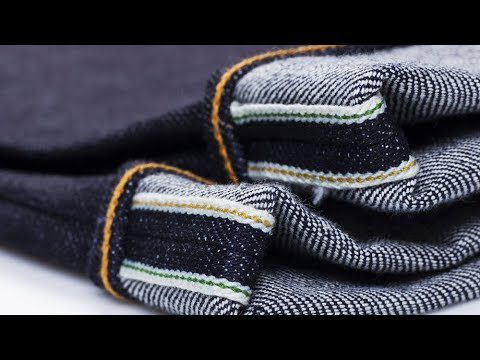The first soak is a crucial first step when it comes to your brand new selvedge denim jeans. Find out how and why!
This is going to come with really quite a lot of disagreement from the raw denim community at large. But 99% the hardcore denimheads I know, insist that this is essential in not only the fading process but also ensuring your jeans last a good long time.
Now, at this point, I will add that this only applies to sanforized denim, unsanforized denim NEEDS to be soaked. There are no two ways about it. For a full rundown about sanforized vs unsanforized, head over to the vlog on exactly that subject from a few weeks ago. But read on (or simply watch the video). The soaking process applies to both types of denim anyhow.
First of all, let’s debunk the arguments against.
There are generally two arguments against soaking.
First up, it makes the fabric too soft for getting those crisp, defined fades we all strive for.
This is Bullshit
Yes, one of the main reasons to soak the denim is to remove a lot of the starch and other nasty chemicals that were added to the cotton during the weaving and sanforization process. This in no way will make the denim limp and soft. Indeed, you might find that the jeans feel even crisper when they are dry after the soak.
It will happen anyway
Your whiskers, honeycombs and stacks are going to set in whether you soak or not. It is simply the way that the fabric fits the movement of your body. The effect of starch will be so minimal to your fades setting in but it will be detrimental to the health of the cotton fibres and therefore the longevity of your beloved project jeans.
Argument against no. 2
It removes too much indigo and the indigo in the water will bleed into the core of the fibres and your fades will be unspectacular and lacklustre. This isn’t bullshit, this is horseshit.
A note on how and why jeans fade.
Indigo is not all that good of a dyestuff if you look at it from the point of view of making white cotton yarn blue. It doesn’t penetrate the fibres all that well, and it rubs off. When the cotton yarn is dyed with indigo it is dipped in a vat of indigo numerous times. It is the outside of the yarn that picks up the blue colour, the inside remains white. The yarn is then woven into denim and the denim made into jeans.
With wear and tear, the colour on the outside of the yarn wears off, revealing the white core. Hence your fades.
Now, I plan to do a whole episode on this so I won’t go into too much detail here. The point is, it takes a lot to wear off the indigo on the yarn, that’s why well-faded jeans take so much time.
Any indigo that bleeds off in the water during the soak was just lying on the surface of the yearn and would come off quickly in other more inconvenient places such as your mum’s white couch, your white trainers or your car seats.
And this brings us to the utterly ridiculous part. Some people think that this watery weak indigo in the bathwater will bleed into the core of the yarn and dye it blue resulting in no fades!
Elephant shit!
This yarn has been through super concentrated indigo dye vats normally over a dozen times. Indigo dye vats look like this. If the industrial strength, industrially processed indigo dying couldn’t dye the core of the yarn, do you really think that this weak bath water will do anything?
Sticking to Soaking
So, to the advantages of soaking. Well, they are basically just what I stated above. It gets rid of a lot of the nasty chemicals used during the milling of the denim and it removes any excess indigo that’s just lying on the surface of the fabric and that will end up in awkward places.
Why are the chemicals there in the first place?
Why do we want to get rid of these chemicals? Well, it will make the jeans more durable. Starch and other things are added to the yarn to ensure they pass smoothly through the eyelets and other bits and bobs of a loom. It makes the cotton very dry and brittle and therefore makes the denim dry and brittle. Getting rid of these chemicals nourishes the fibres, makes them tighten up ever so slightly and means that the denim will last longer as you wear the jeans.
So, soaking doesn’t affect your fades, will keep your mum and her white sofa happy and will make the jeans last longer.
Why wouldn’t you do it!
Ok. right you’re going to soak. Good. It’s the right choice. But just how do you do it?
We need a few things.
- First, we need glasses, lots of them.
- Second, we need a bathtub. Just one will do.
- Oh, and your new jeans.
Now, the Benzaks have had their soak for the reasons I explained in the big reveal video. So I am going to use the Joe & Co.’s from a few weeks ago.
The dreaded smurf paws!
I am really curious to see how much indigo comes out of these. These are a really deep hue and when I was doing the review I did get the smurf paws…. blue hands.
I always like to use warm water, not hot but warm. Run a few inches in the bottom of the bathtub and throw in the jeans. Make sure there is enough water so each and every part of the jeans gets covered. You’ll have to agitate them quite a bit, get all the air out and make sure they are soaked through.
Then you take the glasses and use them to weigh down the jeans. Then you just simply leave them be for 20 mins or so. After 20 mins, you come back and give them another good agitation. And leave them for another 20 mins.
Don’t mess this part up!
Now, this is the part that I find most people mess up on. Drying them. Ideally, I would have them hanging up outside, not in direct sunlight on a warm day. However, it is February in Berlin and it is about -1 outside. So I am going to hang them up right here in the bathroom.
I like to use these S hooks you can pick up in Ikea. They are stainless steel so no rusting against the wet fabric and it allows me to hang them just about anywhere.
So take them out of the bath, making sure not to break any of the glasses hold them up to remove as much of the water as possible put an S hook into the outermost right and left belt loop and hang them up.
Listen Up!
Now here comes the essential part. You open up the legs and the seat so the air can flow freely. Remember, these are coming straight out of the water, they have not been on your usual spin cycle which would remove a lot of the water. So if you want to avoid that foosty smell you need to allow them to dry as quickly as possible.
Then it is just a matter of waiting. Usually, I will give a good 24 hours for the jeans to dry fully. Don’t be tempted to wear them out damp or god forbid, wear them from wet. You’ll just be back doing another soak to try and bring in the weird stretches you made.
Easy as that!
There you have it. This now brings us right up to closing this guide to getting your perfect jean. You should have an amazing pair of raw selvedge denim jeans by now that fit your style, look and your lifestyle and after this first soak you’re good to go on this journey to amazing fades.


